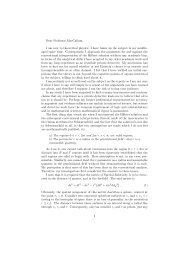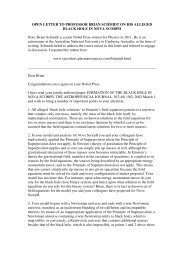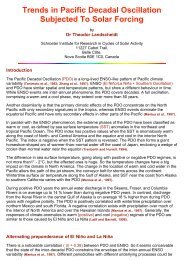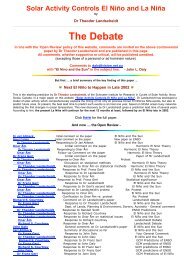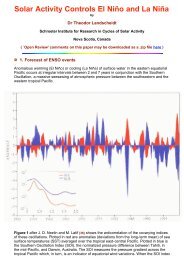Sun-Earth-Man - PlasmaResources
Sun-Earth-Man - PlasmaResources
Sun-Earth-Man - PlasmaResources
You also want an ePaper? Increase the reach of your titles
YUMPU automatically turns print PDFs into web optimized ePapers that Google loves.
14 SUN-EARTH-MAN' A MESH OFCOSMIC OSCILLATIONS II. EXAMPLE AVAILSTEN TIMES MORE THAN PRECEPT - 15<br />
boundary phenomenon releases instabiIity together with a wealth of new<br />
patterns in the <strong>Sun</strong>'s surface that is followed by corresponding effects in the<br />
<strong>Earth</strong>'s surface region. These terrestrial responses, that will be dealt with in<br />
detail irr another chapter, range from geomagnetic storms to abundance in wild<br />
life and economc change.<br />
3. VAIUATION IN WILD LIFE ABUNDANCE, A PARADIGM OF<br />
TERRESTRIAL EFFECTS OF SOLAR SYSTEM BOUNDARY EVENTS<br />
Now we are ready to make an interesting point in our example. Figure 5, after<br />
Edward R. Dewey,'' shows the cyclic variation in Canadian lynx abundance<br />
for the years 1735 to 1969. The data are based on records of the offerings of<br />
lynxskins by trappers, particularly to the Hudson's Bay Company. As the<br />
efforts of trappers to earn a livelihood are fairly constant, biologists feel that<br />
the records of skin offerings constitute a rather reliable index of the abundance<br />
of lynx. The ordinate axis in Figure 5 indicates the yearly number N of offered<br />
lynx skins. Flat triangles mark the epochs of conjunctions of Jupiter with the<br />
centre of mass. These epochs show an obvious connection with extrema in the<br />
Iynx abundance. The pattern, however, is rather complex. There are longer<br />
periods wth epochs that coincide with peaks, as before 1789, other protracted<br />
periods with epochs that concur with troughs, as after 1867, and phase jumps<br />
from minima to maxima as before 1823 and 1867. Such phase changes appear<br />
in almost all time series of solar and terrestrial data and are thought to pose<br />
- intricate questions. The first three arrows in the plot point to periods of<br />
instability resulting in phase jumps that started about 1789, 1823, and 1867.<br />
Even these periods of change show a distinct pattern: the epochs of Jupiter<br />
conjunctions on the left of the respective arrows always coinade with a<br />
maximum in lynx abundance, whereas the epoch on the right concurs with a<br />
minimum. This regular pattern of instabilities yields different results<br />
depending on whether the foregoing epochs of Jupiter conjunctions go along<br />
with maxima or minima in the time series. Only the instability event starting<br />
in 1933 resulted in a different pattern: there was no phase change, but an<br />
anomalous period with very small numbers of lynx and poor variations in the<br />
abundance.<br />
Fortunately, our knowledge of the fundamental quality of boundaries,<br />
derived from mathematical feed-back cycles and physical phase transitions,<br />
when combined with astronomical facts and astrologica1 imagination, enables<br />
us to explain and predict such instabdty events. The centre of mass of the<br />
solar system is an attractor as defined above. Hemam Haken, the founder of<br />
synergetics, a new discipline dealing with nonequilibrium phase transitions<br />
and self-organization in physics and bioIogy, has focused attention on<br />
profound analogies between completely different systems when they pass<br />
through an instability and then build up new macroscopic spatio-temporal<br />
patterns. Haken explicitly states that the equations of celestial mechanics<br />
follow the rules of synergetics, and he stresses in addition that centres of mass<br />
of systems of astronomical bodies play an important part in nonequiIibrium



